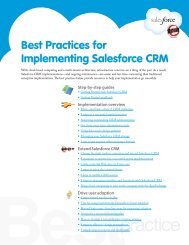Database.com REST API Developer's Guide - Salesforce.com
Database.com REST API Developer's Guide - Salesforce.com
Database.com REST API Developer's Guide - Salesforce.com
- No tags were found...
Create successful ePaper yourself
Turn your PDF publications into a flip-book with our unique Google optimized e-Paper software.
Introducing Force.<strong>com</strong> <strong>REST</strong> <strong>API</strong>Understanding OAuth Endpoints4. Select Enable OAuth Settings.5. Enter a Callback URL. Depending on which OAuth flow you use, this is typically the URL that a user’s browser isredirected to after successful authentication. As this URL is used for some OAuth flows to pass an access token, the URLmust use secure HTTP (HTTPS) or a custom URI scheme.6. Add all supported OAuth scopes to Selected OAuth Scopes. These scopes refer to permissions given by the user runningthe connected app.7. Enter a URL for Info URL. This is where the user can go for more information about your application.8. Click Save. The Consumer Key is created and displayed, and the Consumer Secret is created (click the link to revealit).Once you define a remote access application, you use the consumer key and consumer secret to authenticate your application.See the <strong>Database</strong>.<strong>com</strong> online help for more information about connected apps.Understanding OAuth EndpointsOAuth endpoints are the URLs you use to make OAuth authentication requests to <strong>Database</strong>.<strong>com</strong>.You need to use the correct <strong>Database</strong>.<strong>com</strong> OAuth endpoint when issuing authentication requests in your application. Theprimary OAuth endpoints are:• For authorization: https://login.database.<strong>com</strong>/services/oauth2/authorize• For token requests: https://login.database.<strong>com</strong>/services/oauth2/token• For revoking OAuth tokens: https://login.database.<strong>com</strong>/services/oauth2/revokeAll endpoints require secure HTTP (HTTPS). Each OAuth flow defines which endpoints you need to use and what requestdata you need to provide.If you’re verifying authentication on a test organization, use “test.database.<strong>com</strong>” instead of “login.database.<strong>com</strong>” in all theOAuth endpoints listed above.Understanding the Web Server OAuth Authentication FlowThe Web server authentication flow is used by applications that are hosted on a secure server. A critical aspect of the Webserver flow is that the server must be able to protect the consumer secret.In this flow, the client application requests the authorization server to redirect the user to another web server or resource thatauthorizes the user and sends the application an authorization code. The application uses the authorization code to requestan access token. The following shows the steps for this flow.5
















